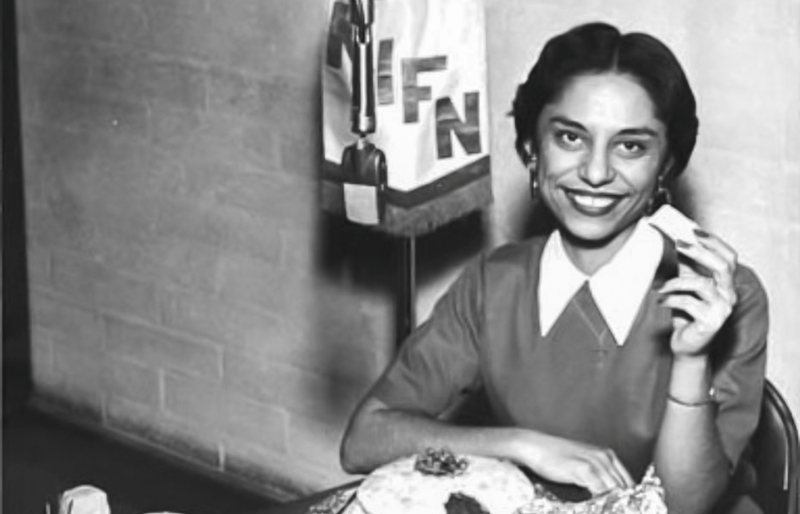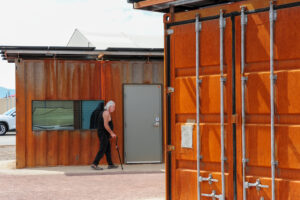Esperanza, or Hope, Mendoza Schechter, labor leader, born in 1921 in Miami, Arizona; Romana Acosta Bañuelos, businesswoman and former United States Treasurer, born in 1925 also in Miami, Arizona; and Graciela Gil Olivarez, government official, educator, and former Director of the Community Services Administration, appointed by President Jimmy Carter, born in 1928 in Barcelona, Arizona. They are ordinary Mexican American women who did extraordinary things.
Esperanza, or Hope, Mendoza Schechter
Labor leader, born in 1921 in Miami, Arizona; Romana Acosta Bañuelos, businesswoman and former United States Treasurer, born in 1925 also in Miami, Arizona; and Graciela Gil Olivarez, government official, educator, and former Director of the Community Services Administration, appointed by President Jimmy Carter, born in 1928 in Barcelona, Arizona. They are ordinary Mexican American women who did extraordinary things.
Related → The Mexicanas of the Tempe Normal School
What they had in common was their Mexican heritage, Spanish language, Mexican traditions and customs. What they had in common was their poverty. And what they most had in common was that their fathers were laborers in the copper mines of Arizona. Their fathers’ heritage and poverty and brown skin made them easy targets of racism, discrimination, and a dual wage system of pay, common in Arizona mining towns such as Miami and Barcelona in the 1900s. The fathers endured. They endured for the sake of the family, conditions such as these:
On June 1, 1903, the Twenty-second Arizona Legislature passed an act directed against mining companies employing Mexican workers, who traditionally worked underground at various mines. This act also prohibited more than eight hours of underground work in these mines. This eight-hour law excluded the mill and smelter workers, who were mainly Anglos, and who were represented by the Western Federation of Miners, the WFM. Mexicans were not welcomed into the WFM because the Mexicans were willing to work ten to twelve hours a day at a wage that Anglo miners felt would cut the WFM union scale by almost 50%. Anglos saw the Mexican underground miner as a job competitor, an inferior laborer: one who lowered the WFM pay scale, and one who stood to reduce his American wage.
When mine owners refused to pay the Mexican miners the union scale, which averaged about three dollars for a ten-hour day, they staged a labor strike and refused to work. The Mexicanos used the strike as a protest against an unfair system of pay: the boleta system, where Mexican miners were paid differently than Anglo miners. Anglo miners were paid in American currency. They could cash their paychecks at their local banks in town. Mexican miners, on the other hand, were paid in boletas, a form of scrip, or promissory notes, redeemable for goods such as flour, coffee, beans, or salt at the company store, which was owned by the mine. Mine owners would frequently raise the prices of these goods at will. Scrip not used was allowed to be exchanged for cash at the end of the month, but at a 25 % reduction value, which was determined by the mine company. The scrip was equal to approximately 66% to 80% of their American face value.
The workplace was another difference between the Anglo worker and the Mexican worker. Change rooms were not provided for the Mexican workers as they were for the Anglo workers. Mexican workers frequently came off their work shifts in unclean and wet clothing. They had no choice but to walk home in their work clothes because Mexican workers were not allowed to use the change rooms provided for the Anglo workers. When Ramón Mendoza, Manuel Acosta, and Damian Gil—the fathers of Hope Mendoza Schechter; Romana Acosta Bañuelos and Graciela Gil Olivarez—experienced these injustices, they supported the labor strikes which called attention to their working conditions simply because they were wrong, unfair, and unjust. This commitment to eradicate injustice and support efforts to bring about cultural understanding and equality was somehow transferred from father to daughter early in their lives.
The Mendoza family found life in Miami, Arizona uncertain and difficult, and left Miami to join family in Los Angeles when Hope was a young girl. They believed that the move would provide Hope with better educational opportunities. But her education was interrupted in 1938 when she dropped out of high school to work in the garment industry. After a period of working in defense factories during World War II, Hope Mendoza returned to the garment industry, and soon became an active labor organizer for the International Ladies Garment Workers Union, the ILGWU. The ILGWU sought to organize the Mexican women in Los Angeles garment factories, whose work and labor were being exploited, and Hope supported her union’s effort to do so. She served as business officer for the ILGWU until the mid-1950s. During the late 1940s and early 1950s, she also became involved in community and state politics, serving on committees of the state Democratic Party and the Central Labor Council, and founding, with other labor organizers, the Los Angeles Community Services Organization, on whose board she served for seven years. Mendoza’s 1955 marriage to Harvey Schechter prompted her to finish her high school education. In 1961, she used the skills that she learned as a shorthand reporter to establish the Schechter Deposition Service. In 1972, Schechter was inducted into the Los Angeles Justice Lodge of B’nai B’rith as a court reporter, becoming one of the first females to enter the all-male organization. Hope Mendoza Schechter’s devotion to community and political and labor causes on behalf of Mexican Americans increased after her marriage, as she became a member of the Board of Directors of the Council of Mexican American Affairs and the Mexican American Youth Opportunities Foundation. Here, she became involved with youths involved with the Chicano Movement in Los Angeles, a civil rights movement whose goals were to correct forms of injustice against Mexican Americans. Because of her work in civil rights, Hope Mendoza Schechter was named to the Peace Corps National Advisory Council by President Lyndon B. Johnson in 1964. Throughout her life, she has been devoted to the concerns of the Mexican American community in Los Angeles.
Romana Acosta Bañuelos
She began what would become a highly successful business with an aunt and a tortilla machine; founded a bank; and became Treasurer of the United States and served under President Richard M. Nixon during the period from 1971 to 1974. Acosta was born on March 20, 1925 in Miami, Arizona, the daughter of a copper miner. Her parents were born in Mexico and the family was poor. In 1933, as the effects of the Great Depression were still being felt throughout the country, Arizona officials told a number of Mexican families in Miami, including the Acosta family, that they had to return to Mexico. They became repatriates, or deportees, and encountered other Mexican families and friends on the trip to Mexico. Young Romana, a child of eight years of age, never forgot the humiliating and shocking experience of becoming unwanted Mexicans, and joining the migrant stream.
By the time she was nineteen years of age, Romana had married, borne two sons and was a divorcee. She packed up her children and returned to her native country, the United States, in 1944. She went to Los Angeles, where she hoped to find work in defense plants during World War II. By 1946, she had managed to save $400 factory-work money. With this savings, and the help of an ambitious aunt, a tortilla machine, a grinder, and a fan, Romana Acosta Bañuelos set up a tortilla factory in the heart of Los Angeles. Post World War II business boomed, and by 1964, Romana and her aunt were able to establish Ramona’s Mexican Food Products, Inc. Success and profits were just around the corner. But Romana Acosta Bañuelos never forgot the poor, unfortunate Mexican families and their children who were being deported to Mexico during the Great Depression, and vowed to herself that she would help the less fortunate in her Mexican American community of Los Angeles.
In the mid-1960s, she founded Ramona’s Mexican Food Products, Inc. Scholarship Foundation, which assisted Mexican American high school graduates in their educational goals. Another of her goals was economic and community empowerment. In 1965, she and other partners created the Pan-American National Bank, and by 1969, Romana Acosta Bañuelos became the Chair of the Board of Directors of the bank, and received recognition from her peers in the business world. By 1979, Pan-American National Bank held deposits of $38,864,000 and assets of $41,472,000. By 1992, Romana Acosta Bañuelos had served as Chair of the bank’s Board of Directors for three terms of office. But it was Bañuelos’ business talent that wielded political influence for her during the early 1970s. President Richard M. Nixon selected her as his candidate for United States Treasurer, a position she held for three years. In recent years, Romana Acosta Bañuelos has divided her time between Ramona’s Mexican Food Products, Inc., and the Pan-American National Bank.
Graciela Gil Olivarez
Equally remarkable is Graciela Gil Olivarez, the first woman and the first Mexican American woman to graduate from Notre Dame Law School in 1970. Graciela Gil Olivarez was born on May 9, 1928, in Barcelona, Arizona, a copper mining town near Miami, Arizona. Her father worked near Barcelona as a miner. Although she dropped out of Ray [Arizona] High School at the age of 15 when her family moved to Phoenix in 1944, Graciela did not let her lack of a degree affect her confidence. She attended Lamson’s Business school and soon found work as a stenographer and a translator for a real estate agent. Her work also put her in contact with businessmen at a Spanish-language radio station in Phoenix, KIFN, who recognized Graciela’s business and language skills and ease within the Mexican American community. They took her away from the real estate environment and placed her in the world of broadcasting. By 1952, Graciela Gil held a position as the women’s program director of KIFN, and became locally famous as Phoenix’s first female disc jockey. But in her work, she was exposed to the poverty among those who tuned in to her radio program: destitute Mexican and Mexican American families in the migrant labor camps of surrounding Phoenix, and those who lived in what was called the “inner city”: south Phoenix.
Graciela began to call attention to the plight of these families in her radio program, but was soon criticized by the owners of the station for her commentaries about the migrant families. The owners felt that Graciela’s role was to continue programming in the culinary arts, Latin jazz, and women’s programs. When she had the opportunity to help the poverty-stricken in her Mexican American community, Graciela took it. The philanthropist, Robert B. Choate, of the prominent Choate family from Massachusetts, initiated the program, “Careers for Youth,” in Phoenix, and he asked Graciela to work for him counseling Mexican American families in south Phoenix. Her work among the poor gained her recognition and success. In 1965, she became the State Director of the Office of Economic Opportunity for Arizona, and was later appointed by President Lyndon B. Johnson as a member of the National Advisory Council, created by Congress and directed by Sargent Shriver. And her work in the civil rights movement became equally known.
The President of Notre Dame University, Reverend Theodore Hesburgh had met Graciela and became familiar with her work. He encouraged her to return to school and suggested that she attend Notre Dame’ s Law School. Although Graciela was already in her late 30’s and did not have the educational qualifications to do so, she decided to take the Reverend up on his offer. At the age of 42, in 1970, Graciela Gil Olivarez graduated from the Notre Dame School of Law—the first woman and the first Mexican American woman, or Chicana, as she called herself, to do so. Graciela returned to the Southwest, taught law at the University of New Mexico, and worked for various government agencies, including the Governor of New Mexico, Tony Anaya. By 1975, Graciela’s efforts to decrease poverty caught the attention of President Jimmy Carter. In 1977, he appointed her as the Director of the Community Services Administration and became the highest-ranking Mexican American woman in Carter’s administration, a post she held until 1980.
Three women. Three Arizona Latinas: Hope Mendoza Schechter; Romana Acosta Bañuelos; and Graciela Gil Olivarez. Daughters of copper miners, born into poverty and surrounded by the events of their time: labor disputes; wage inequities based on ethnicity; Mexican deportations; and cultural insensitivities. Three Latinas who rose above their surroundings to become achievers and contributors to the development of their country.
Mendoza-Schechter; Acosta-Bañuelos; and Gil-Olivarez: good, solid, American Spanish surnames. They are ordinary women who did extraordinary things. They persevered and endured economic hardships. And they should be remembered for what they did and who they are: three Arizona women.
© 2006 - 2025, Dr. Christine Marin. All rights reserved.





